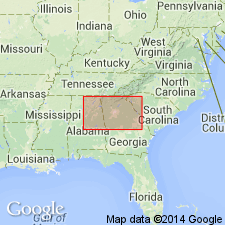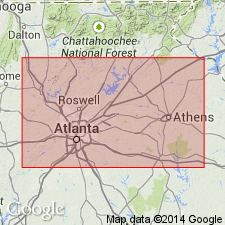
- Usage in publication:
-
- Paulding Volcanic-Plutonic Complex*
- Modifications:
-
- Named
- Dominant lithology:
-
- Amphibolite
- Gneiss
- AAPG geologic province:
-
- Piedmont-Blue Ridge province
Summary:
The Paulding Volcanic-Plutonic Complex in the Paulding thrust sheet, GA and AL, is here named for exposures in Paulding Co., GA, and a type section is designated. It is an igneous unit, devoid of clastic metasedimentary rocks and consists of light-green weathering, epidote-rich, generally chloritic, green or blue-green amphibolites interlayered with granofels and gneisses. Dikes, sills, and small plutons of granitic rocks and epidosite pods are common. Paulding rocks have been named the Waresville and Ketchepedrakee Amphibolites and Hillabee greenstone in AL, and Waresville Amphibolite, Pumpkinvine Creek Formation, and part of the New Georgia Group in GA. The Waresville, Pumpkinvine Creek, and New Georgia are here abandoned. The Ketchepedrakee and Hillabee are used informally. Age is Cambrian to Early Ordovician(?).
Source: GNU records (USGS DDS-6; Reston GNULEX).

- Usage in publication:
-
- Paulding Volcanic-Plutonic Complex*
- Modifications:
-
- Revised
- Age modified
- AAPG geologic province:
-
- Piedmont-Blue Ridge province
Summary:
Field mapping during 1992 of Soapstone Ridge area indicated that the area thought to be underlain by a mafic-ultramafic complex (Soapstone Ridge Complex) is actually underlain by Paulding Volcanic-Plutonic Complex with an abundance of mafic and ultramafic blacks and slabs and that rocks of the Paulding are surrounded by Stonewall Gneiss like a sheath. Plunges of minor fold axes, mineral elongations, crenulations, and other lineations are consistently eastward at 20 to 30 degrees in both Paulding and Stonewall; it appears that Paulding and Stonewall occupy a sheath fold, with Paulding being the "knife" in the fold. Because rocks previously designated Soapstone Ridge Complex belong to the Paulding, the name Soapstone Ridge Complex is abandoned. Age of Paulding Volcanic-Plutonic Complex of the allochthonous assemblage is changed to Late Proterozoic(?) to Middle Ordovician(?) based on a more conservative theory that the allochthonous rocks are 1) probably not older than Late Proterozoic because they are not part of Middle Proterozoic (Grenvillian) basement and 2) they could be as young, but not younger than, the time marking the beginning of closure of the ocean they originated in, as set by the slope reversal marked by deposition of Middle Ordovician Rockmart Slate upon unconformity at top of Upper Cambrian to Middle(?) Ordovician Knox Group and Middle Ordovician Lenoir Limestone. Report includes geologic map and correlation chart.
Source: GNU records (USGS DDS-6; Reston GNULEX).
For more information, please contact Nancy Stamm, Geologic Names Committee Secretary.
Asterisk (*) indicates published by U.S. Geological Survey authors.
"No current usage" (†) implies that a name has been abandoned or has fallen into disuse. Former usage and, if known, replacement name given in parentheses ( ).
Slash (/) indicates name conflicts with nomenclatural guidelines (CSN, 1933; ACSN, 1961, 1970; NACSN, 1983, 2005, 2021). May be explained within brackets ([ ]).

